Blog > 10 creative Ideas for your Title- and End-Slides in Presentations

10 creative Ideas for your Title- and End-Slides in Presentations
11.13.19 • #powerpointtips #presentation.
Of all the slides in a PowerPoint presentation, the ones that are without a doubt the most important ones are the first and the last one. It makes perfect sense – the title slide sets the general tone. Make it boring and you’ll loose your audience’s attention within the first few minutes. If you’re making it exciting and innovative on the other hand, you’re taking a big step towards giving an amazing presentation and having an engaged audience. It is very similar with the final slide. It will be the one that people are going to remember most, the one that is supposed to make people leave the room thinking ‘Wow! What a great presentation!’ A bad ending could even mess up what would otherwise be a good performance overall (just think of a good TV show with a bad ending…).
The most common mistakes for title and final slides
If you asked 100 people what belongs on your PowerPoint’s title slide, the majority would answer ‘The title, maybe a subtitle, the presenter’s name and company, the date’. That kind of title slide is alright, but you usually say all of these things in the beginning of a presentation anyway. Also, it is very likely that most of your attendees know these things – they usually signed up for it after all. So what’s the point in listing all of that information on your title slide, when you could also use it for making a stunning first impression? Not only the title slide is commonly designed in an uncreative and conventional way. Too often, you can see PowerPoint presentations ending with the ‘Any Questions?’ or even worse – the ‘Thank you for your attention’ slide. ‘Thank you for your attention’ is a set phrase that has been said so many times it can’t possibly be delivered in an authentic way anymore. Therefore, it’s better to think of something else for your grand final. Finding an unconventional ending that suits your presentation style makes you seem much more charismatic and authentic than using an empty phrase.
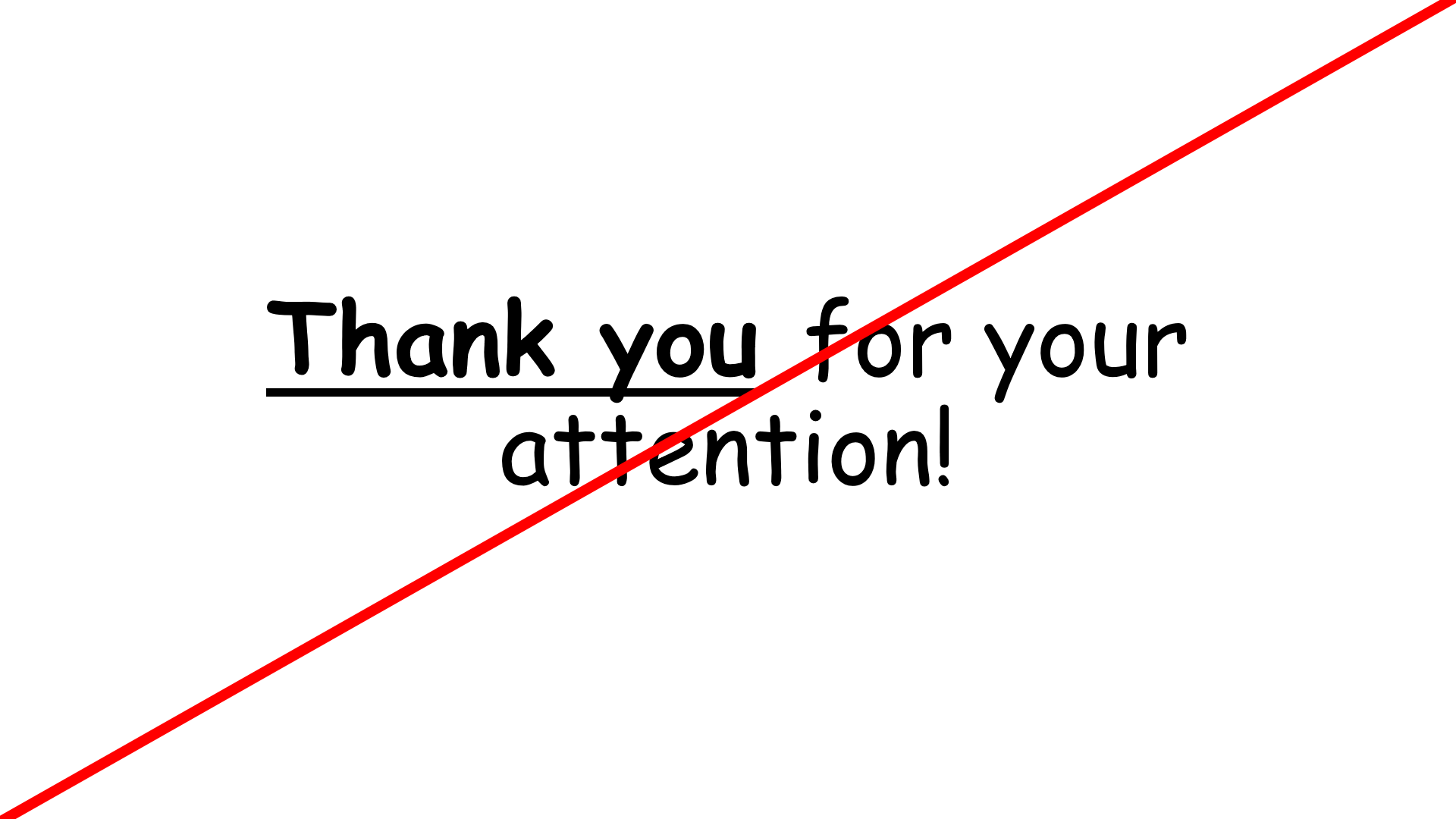
1. An inspiring quote
An inspiring quote on your slide is a perfect way to both start and finish your presentation. Well, it does not have to be inspiring. It could be any quote that is somehow connected to your presented topic. Just have fun looking through books and the internet to find interesting quotes that you want your audience to hear. Good pages to look at for inspiration are goodreads and brainyquotes.com .
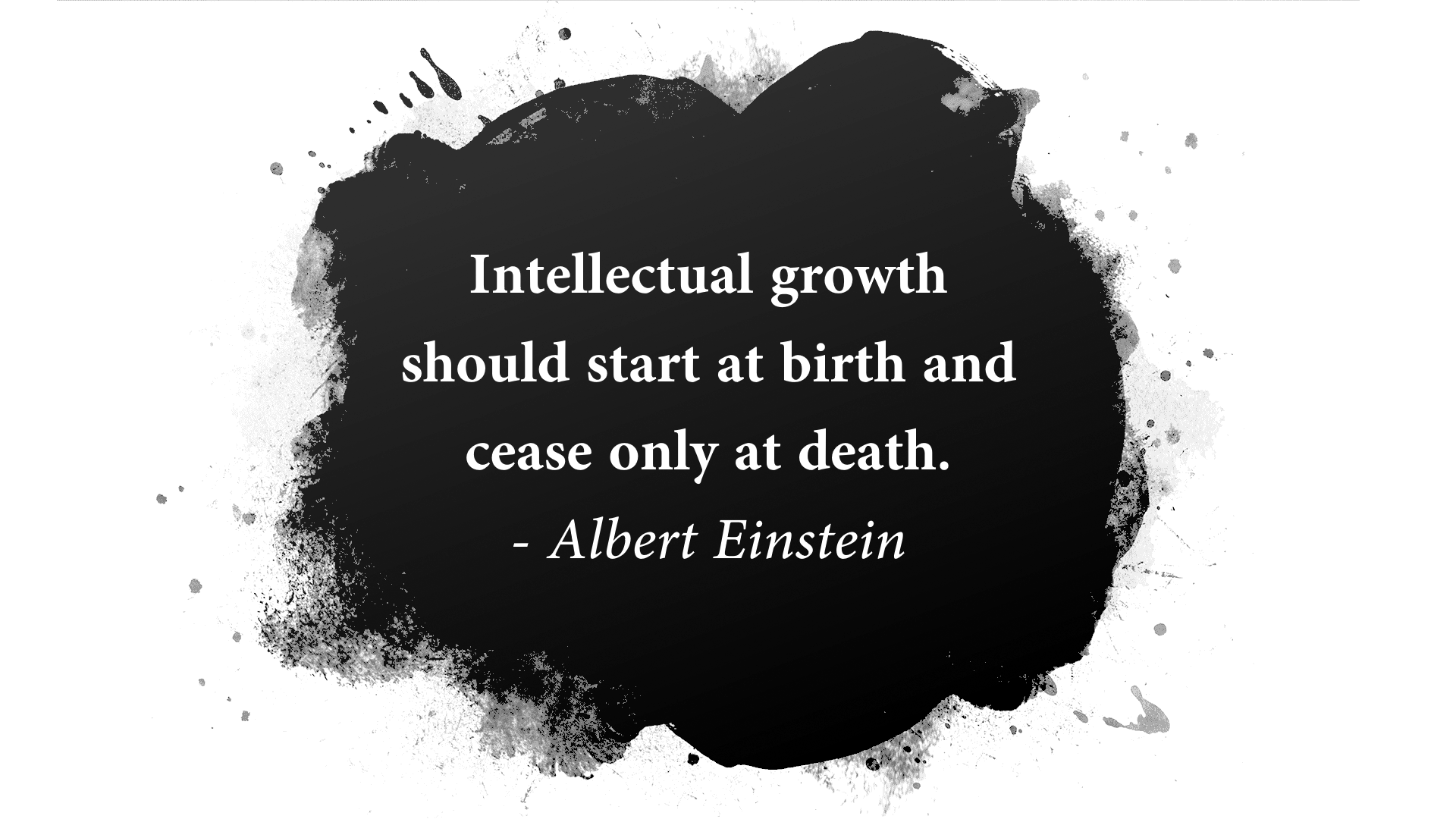
2. A blank slide
This might seem strange to some people, but a blank slide can be really powerful if you want to have your audience’s full attention. You can use the advantage of blank slides by incorporating them at the beginning, in the end or even in between your regular slides. You can either use a blank slide of your regular template (so there will still be some design elements on it) or go all in and make the slide completely black (or white).
3. A call to action
If the goal of your presentation is to really make your audience act in some kind of way, there is no better way to start – or better yet end your presentation than with a call to action. This can be literally anything from little trivial things like “Drink enough water during the presentation so your brain stays intact!” – which will lighten up the mood – to more serious calls like “Help reducing waste by recycling whenever possible!”.

4. A question
Usually, it is the audience that asks questions after a presentation. However, you can also turn that around and ask your attendees instead. However, it’s important to ask a question that can be answered easily and individually – the best questions involve previous experiences and personal opinions (asking about facts or questions that are hard to understand can often lead to silence and no one wanting to answer).
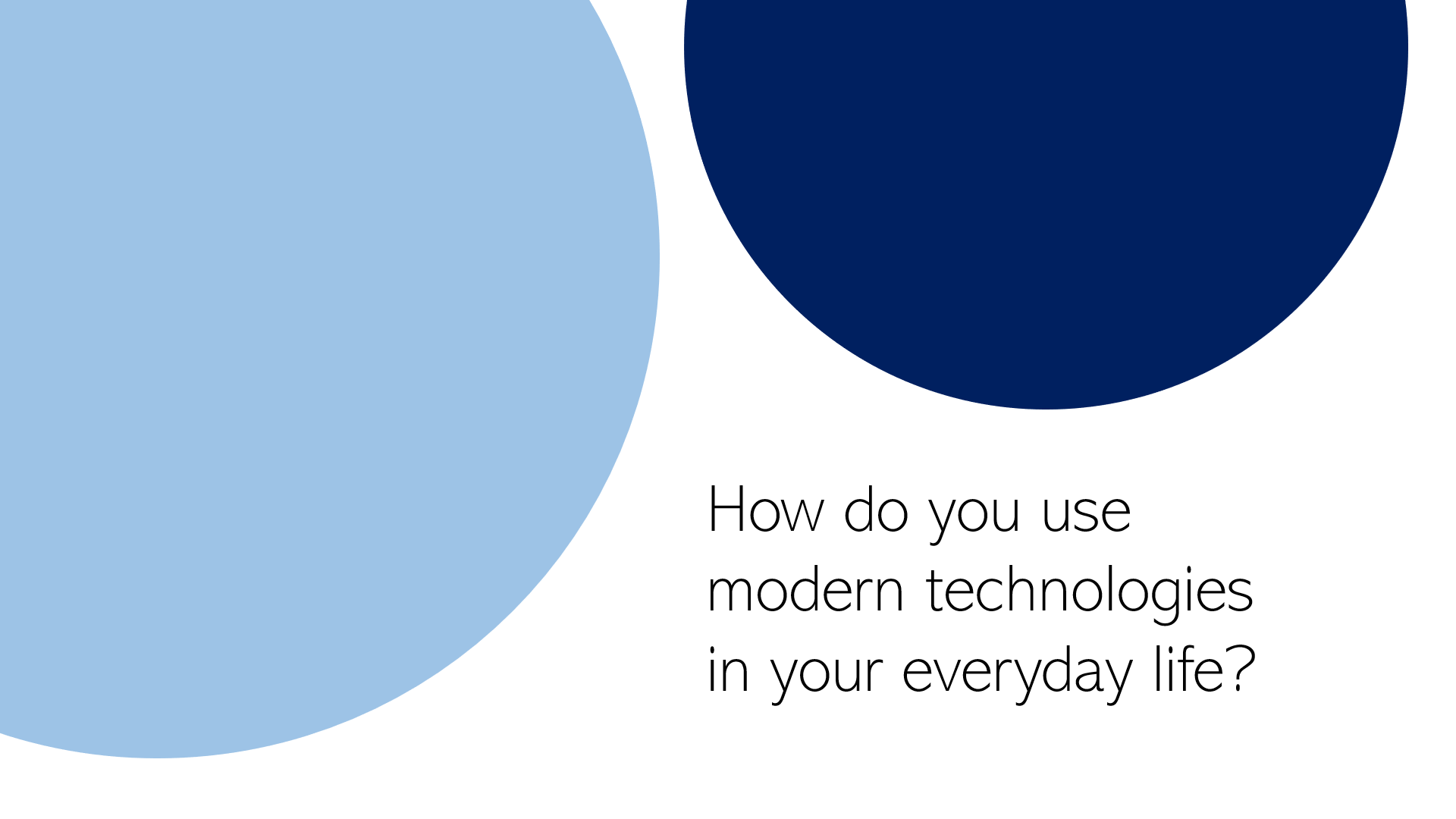
5. An interactive poll
Nothing engages the audience like a live poll. Conduct one right at the beginning to get everybody envolved, and/or wait until the end to get your audience’s opinion on something. Icebreaker polls are the perfect way to start, as they lighten the mood. You can easily create polls for free with interactive software tools such as SlideLizard .
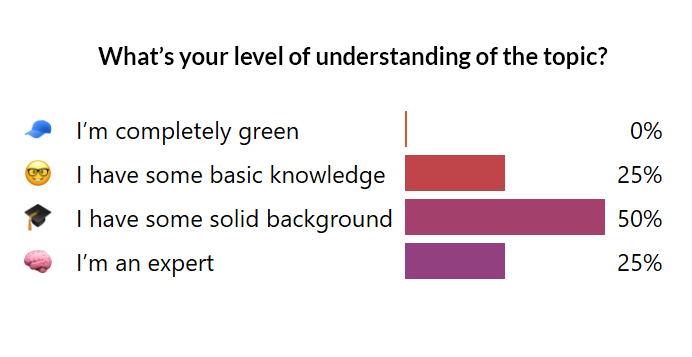
6. A funny picture, meme, or quote
I’m pretty sure that every student nowadays has that teacher that just tries a little too hard to be cool by throwing in a meme on literally every single slide. That may be a bit too much. But just a little comedy at the beginning or in the end can make you seem very charismatic and entertaining and catch the attention of your listeners. Open (or close) with a joke, a funny picture or a quote – whichever you feel comfortable with. It is usually best if it has something to do with the topic you’re presenting.

7. An interesting fact
Catch the audience’s attention by putting an interesting fact concerning the topic on one of your slides – ideally at the beginning, but maybe also in the end (to keep up the audience’s interest even after the presentation is done).
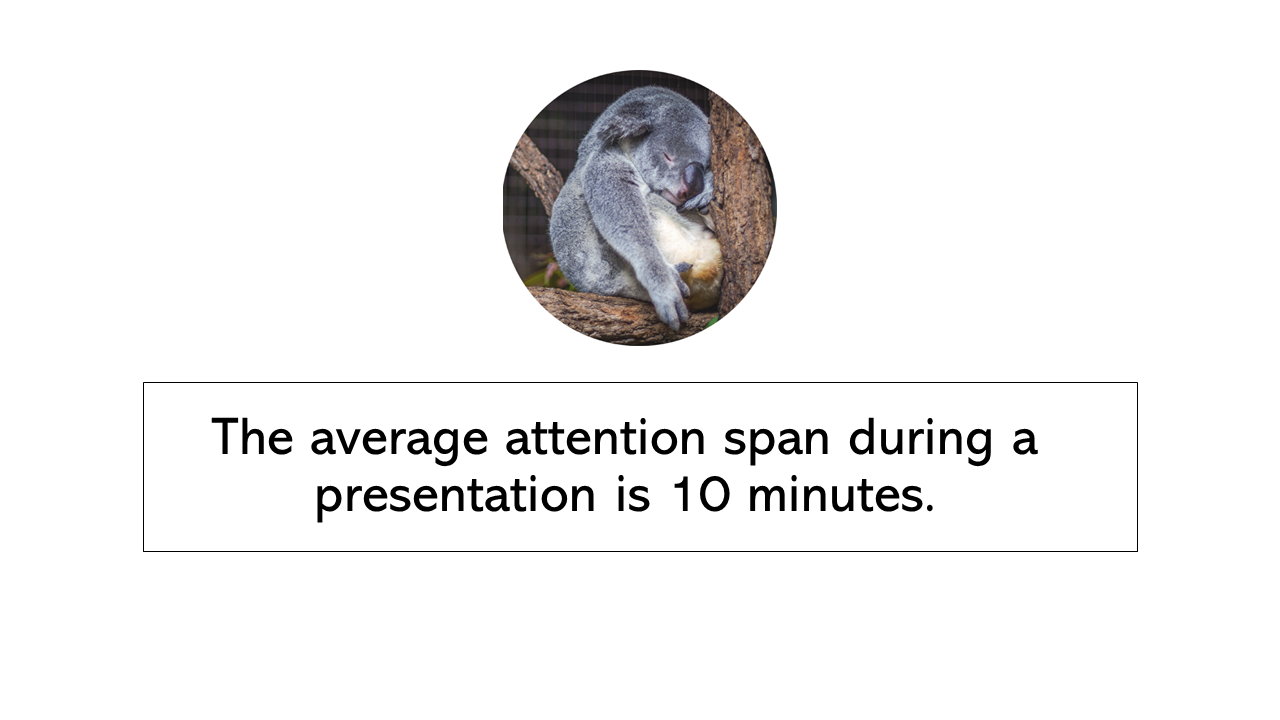
8. The title, but with a twist
If you feel like you need to put the presentations name/topic on the front slide, but still want that little creative twist, just change the title slightly. According to what I’m proposing, rather dull presentation titles like e.g. “Marine Biology – An Introduction to Organisms in the sea” can be transformed to “Marine Biology – Diving Deep” (or something less cheesy if you prefer). Make it either funny or over-the-top spectacular and catch the audience’s attention!

9. A bold statement, opinion, or piece of information
This is probably the best way to capture your audience from the beginning on. Start with a radical, crazy opinion or statement and then get your attendees hooked by telling them that during the presentation, they will learn why you’re right. It could be anything, really, as long as it goes well with your presented topic – from the statement “Everybody has the time to read 5 books a month” to “Going to college is a waste of time” or “The human species is not the most intelligent on earth” – Take whatever crazy, unpopular theory or opinion you have, throw it out there and (very important!) explain why you’re right. You’ll have your audience’s attention for sure and might even change some of their opinions about certain things.
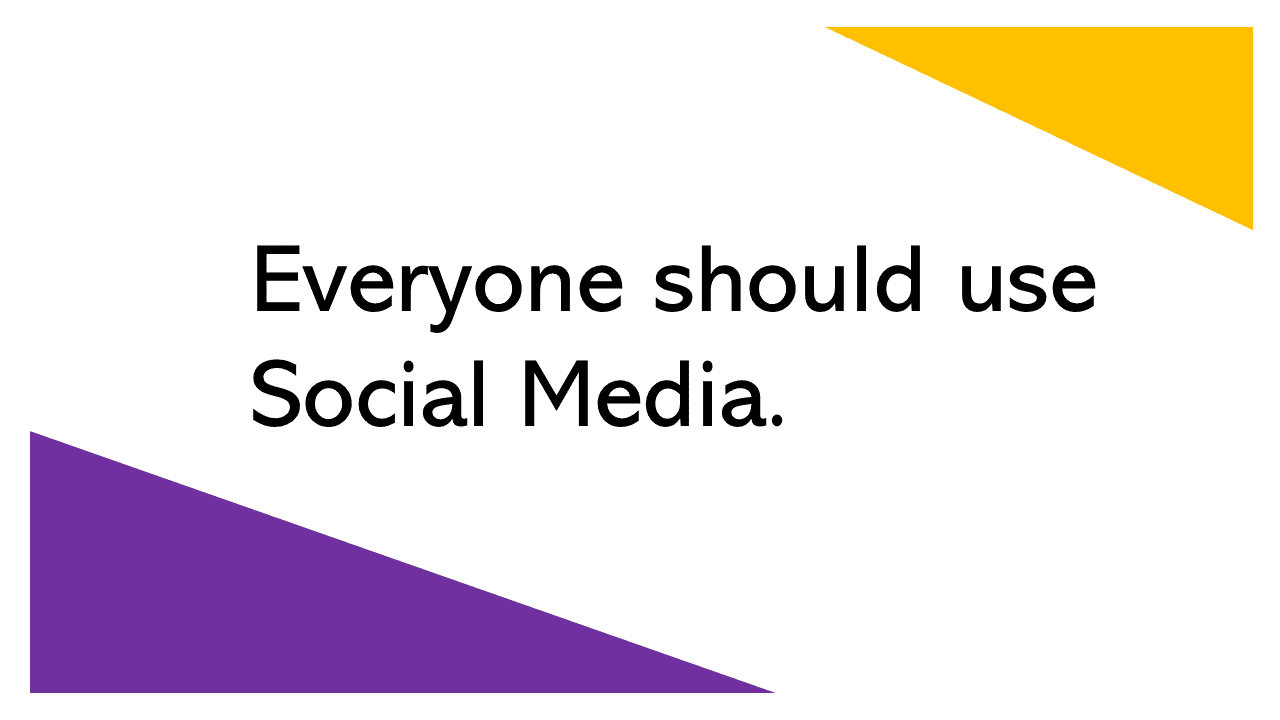
10. No title and end slide at all
Yes, that’s a possibility as well. If you absolutely can’t think of any creative or otherwise good way to start and end your presentation – even after reading the tips mentioned above – then simply don’t. That’s right - no title and end slide at all. You can pull that of by simply introducing yourself in the beginning, then getting right into the topic (which makes a good impression, long introductions are usually rather tedious) and when you’re at your last slide just saying a simple ‘Goodbye, thank you and feel free to ask questions’.
Related articles
About the author.

Pia Lehner-Mittermaier
Pia works in Marketing as a graphic designer and writer at SlideLizard. She uses her vivid imagination and creativity to produce good content.
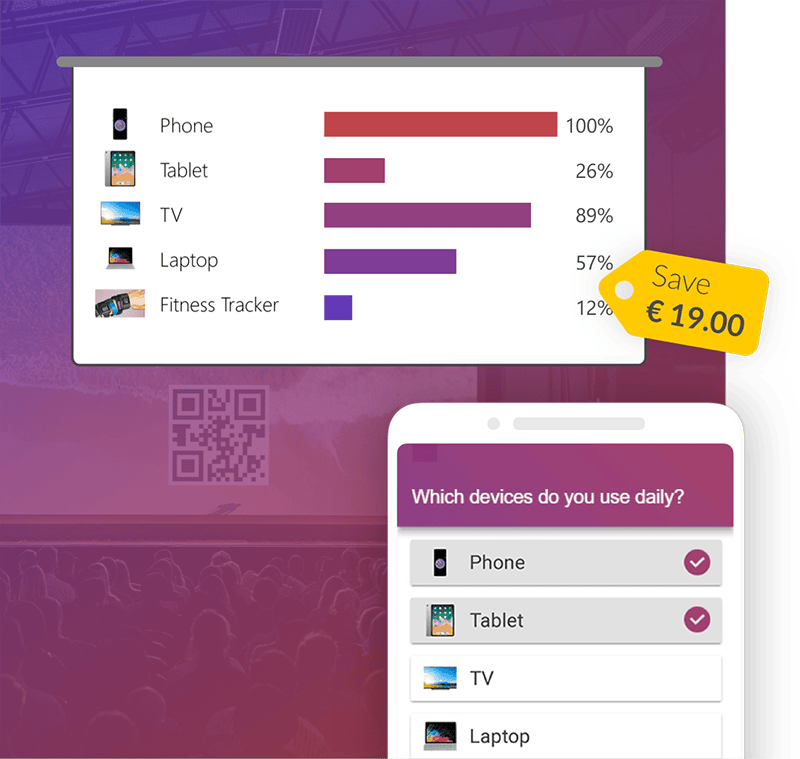
Get 1 Month for free!
Do you want to make your presentations more interactive.
With SlideLizard you can engage your audience with live polls, questions and feedback . Directly within your PowerPoint Presentation. Learn more

Top blog articles More posts

Compress PowerPoint to reduce the file size

How to show PowerPoint slides in Portrait orientation
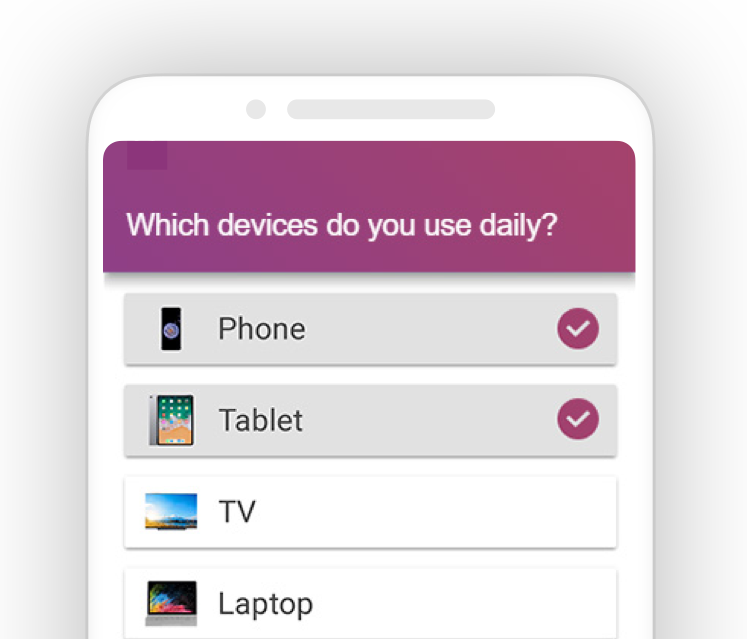
Get started with Live Polls, Q&A and slides
for your PowerPoint Presentations
The big SlideLizard presentation glossary
To interview somebody means to ask a person different questions. An interview is often done by journalists.
Extemporaneous Speech
An extemporaneous speech is a speech that involves little preparation, as the speaker may use notes or cards to give his talk. It is important that speakers will still use their own words and talk naturally. .
Visual Communication
If there are used images or videos for communication, it is visual communication. Visual Communication is almost used everywhere like on television, posts on social media (Instagram, Facebook), advertisement.
.potm file extension
A .potm file is a template for macro-enabled presentations. They are used for creating more .pptm files with the same macro settings and the same formatting.
Be the first to know!
The latest SlideLizard news, articles, and resources, sent straight to your inbox.
- or follow us on -
We use cookies to personalize content and analyze traffic to our website. You can choose to accept only cookies that are necessary for the website to function or to also allow tracking cookies. For more information, please see our privacy policy .
Cookie Settings
Necessary cookies are required for the proper functioning of the website. These cookies ensure basic functionalities and security features of the website.
Analytical cookies are used to understand how visitors interact with the website. These cookies help provide information about the number of visitors, etc.

30 Examples: How to Conclude a Presentation (Effective Closing Techniques)
By Status.net Editorial Team on March 4, 2024 — 9 minutes to read
Ending a presentation on a high note is a skill that can set you apart from the rest. It’s the final chance to leave an impact on your audience, ensuring they walk away with the key messages embedded in their minds. This moment is about driving your points home and making sure they resonate. Crafting a memorable closing isn’t just about summarizing key points, though that’s part of it, but also about providing value that sticks with your listeners long after they’ve left the room.
Crafting Your Core Message
To leave a lasting impression, your presentation’s conclusion should clearly reflect your core message. This is your chance to reinforce the takeaways and leave the audience thinking about your presentation long after it ends.
Identifying Key Points
Start by recognizing what you want your audience to remember. Think about the main ideas that shaped your talk. Make a list like this:
- The problem your presentation addresses.
- The evidence that supports your argument.
- The solution you propose or the action you want the audience to take.
These key points become the pillars of your core message.
Contextualizing the Presentation
Provide context by briefly relating back to the content of the whole presentation. For example:
- Reference a statistic you shared in the opening, and how it ties into the conclusion.
- Mention a case study that underlines the importance of your message.
Connecting these elements gives your message cohesion and makes your conclusion resonate with the framework of your presentation.
30 Example Phrases: How to Conclude a Presentation
- 1. “In summary, let’s revisit the key takeaways from today’s presentation.”
- 2. “Thank you for your attention. Let’s move forward together.”
- 3. “That brings us to the end. I’m open to any questions you may have.”
- 4. “I’ll leave you with this final thought to ponder as we conclude.”
- 5. “Let’s recap the main points before we wrap up.”
- 6. “I appreciate your engagement. Now, let’s turn these ideas into action.”
- 7. “We’ve covered a lot today. To conclude, remember these crucial points.”
- 8. “As we reach the end, I’d like to emphasize our call to action.”
- 9. “Before we close, let’s quickly review what we’ve learned.”
- 10. “Thank you for joining me on this journey. I look forward to our next steps.”
- 11. “In closing, I’d like to thank everyone for their participation.”
- 12. “Let’s conclude with a reminder of the impact we can make together.”
- 13. “To wrap up our session, here’s a brief summary of our discussion.”
- 14. “I’m grateful for the opportunity to present to you. Any final thoughts?”
- 15. “And that’s a wrap. I welcome any final questions or comments.”
- 16. “As we conclude, let’s remember the objectives we’ve set today.”
- 17. “Thank you for your time. Let’s apply these insights to achieve success.”
- 18. “In conclusion, your feedback is valuable, and I’m here to listen.”
- 19. “Before we part, let’s take a moment to reflect on our key messages.”
- 20. “I’ll end with an invitation for all of us to take the next step.”
- 21. “As we close, let’s commit to the goals we’ve outlined today.”
- 22. “Thank you for your attention. Let’s keep the conversation going.”
- 23. “In conclusion, let’s make a difference, starting now.”
- 24. “I’ll leave you with these final words to consider as we end our time together.”
- 25. “Before we conclude, remember that change starts with our actions today.”
- 26. “Thank you for the lively discussion. Let’s continue to build on these ideas.”
- 27. “As we wrap up, I encourage you to reach out with any further questions.”
- 28. “In closing, I’d like to express my gratitude for your valuable input.”
- 29. “Let’s conclude on a high note and take these learnings forward.”
- 30. “Thank you for your time today. Let’s end with a commitment to progress.”
Summarizing the Main Points
When you reach the end of your presentation, summarizing the main points helps your audience retain the important information you’ve shared. Crafting a memorable summary enables your listeners to walk away with a clear understanding of your message.
Effective Methods of Summarization
To effectively summarize your presentation, you need to distill complex information into concise, digestible pieces. Start by revisiting the overarching theme of your talk and then narrow down to the core messages. Use plain language and imagery to make the enduring ideas stick. Here are some examples of how to do this:
- Use analogies that relate to common experiences to recap complex concepts.
- Incorporate visuals or gestures that reinforce your main arguments.
The Rule of Three
The Rule of Three is a classic writing and communication principle. It means presenting ideas in a trio, which is a pattern that’s easy for people to understand and remember. For instance, you might say, “Our plan will save time, cut costs, and improve quality.” This structure has a pleasing rhythm and makes the content more memorable. Some examples include:
- “This software is fast, user-friendly, and secure.”
- Pointing out a product’s “durability, affordability, and eco-friendliness.”
Reiterating the Main Points
Finally, you want to circle back to the key takeaways of your presentation. Rephrase your main points without introducing new information. This reinforcement supports your audience’s memory and understanding of the material. You might summarize key takeaways like this:
- Mention the problem you addressed, the solution you propose, and the benefits of this solution.
- Highlighting the outcomes of adopting your strategy: higher efficiency, greater satisfaction, and increased revenue.
Creating a Strong Conclusion
The final moments of your presentation are your chance to leave your audience with a powerful lasting impression. A strong conclusion is more than just summarizing—it’s your opportunity to invoke thought, inspire action, and make your message memorable.
Incorporating a Call to Action
A call to action is your parting request to your audience. You want to inspire them to take a specific action or think differently as a result of what they’ve heard. To do this effectively:
- Be clear about what you’re asking.
- Explain why their action is needed.
- Make it as simple as possible for them to take the next steps.
Example Phrases:
- “Start making a difference today by…”
- “Join us in this effort by…”
- “Take the leap and commit to…”
Leaving a Lasting Impression
End your presentation with something memorable. This can be a powerful quote, an inspirational statement, or a compelling story that underscores your main points. The goal here is to resonate with your audience on an emotional level so that your message sticks with them long after they leave.
- “In the words of [Influential Person], ‘…'”
- “Imagine a world where…”
- “This is more than just [Topic]; it’s about…”
Enhancing Audience Engagement
To hold your audience’s attention and ensure they leave with a lasting impression of your presentation, fostering interaction is key.
Q&A Sessions
It’s important to integrate a Q&A session because it allows for direct communication between you and your audience. This interactive segment helps clarify any uncertainties and encourages active participation. Plan for this by designating a time slot towards the end of your presentation and invite questions that promote discussion.
- “I’d love to hear your thoughts; what questions do you have?”
- “Let’s dive into any questions you might have. Who would like to start?”
- “Feel free to ask any questions, whether they’re clarifications or deeper inquiries about the topic.”
Encouraging Audience Participation
Getting your audience involved can transform a good presentation into a great one. Use open-ended questions that provoke thought and allow audience members to reflect on how your content relates to them. Additionally, inviting volunteers to participate in a demonstration or share their experiences keeps everyone engaged and adds a personal touch to your talk.
- “Could someone give me an example of how you’ve encountered this in your work?”
- “I’d appreciate a volunteer to help demonstrate this concept. Who’s interested?”
- “How do you see this information impacting your daily tasks? Let’s discuss!”
Delivering a Persuasive Ending
At the end of your presentation, you have the power to leave a lasting impact on your audience. A persuasive ending can drive home your key message and encourage action.
Sales and Persuasion Tactics
When you’re concluding a presentation with the goal of selling a product or idea, employ carefully chosen sales and persuasion tactics. One method is to summarize the key benefits of your offering, reminding your audience why it’s important to act. For example, if you’ve just presented a new software tool, recap how it will save time and increase productivity. Another tactic is the ‘call to action’, which should be clear and direct, such as “Start your free trial today to experience the benefits first-hand!” Furthermore, using a touch of urgency, like “Offer expires soon!”, can nudge your audience to act promptly.
Final Impressions and Professionalism
Your closing statement is a chance to solidify your professional image and leave a positive impression. It’s important to display confidence and poise. Consider thanking your audience for their time and offering to answer any questions. Make sure to end on a high note by summarizing your message in a concise and memorable way. If your topic was on renewable energy, you might conclude by saying, “Let’s take a leap towards a greener future by adopting these solutions today.” This reinforces your main points and encourages your listeners to think or act differently when they leave.
Frequently Asked Questions
What are some creative strategies for ending a presentation memorably.
To end your presentation in a memorable way, consider incorporating a call to action that engages your audience to take the next step. Another strategy is to finish with a thought-provoking question or a surprising fact that resonates with your listeners.
Can you suggest some powerful quotes suitable for concluding a presentation?
Yes, using a quote can be very effective. For example, Maya Angelou’s “People will forget what you said, people will forget what you did, but people will never forget how you made them feel,” can reinforce the emotional impact of your presentation.
What is an effective way to write a conclusion that summarizes a presentation?
An effective conclusion should recap the main points succinctly, highlighting what you want your audience to remember. A good way to conclude is by restating your thesis and then briefly summarizing the supporting points you made.
As a student, how can I leave a strong impression with my presentation’s closing remarks?
To leave a strong impression, consider sharing a personal anecdote related to your topic that demonstrates passion and conviction. This helps humanize your content and makes the message more relatable to your audience.
How can I appropriately thank my audience at the close of my presentation?
A simple and sincere expression of gratitude is always appropriate. You might say, “Thank you for your attention and engagement today,” to convey appreciation while also acknowledging their participation.
What are some examples of a compelling closing sentence in a presentation?
A compelling closing sentence could be something like, “Together, let’s take the leap towards a greener future,” if you’re presenting on sustainability. This sentence is impactful, calls for united action, and leaves your audience with a clear message.
- 30 Examples of Teamwork Self Evaluation Comments
- Effective Nonverbal Communication in the Workplace (Examples)
- 30 Examples of Follow-Up Email Subject Lines
- 5 Effective Examples: How to Write a Two-Week Notice
- 2 Examples of an Effective and Warm Letter of Welcome
- 8 Examples of Effective Interview Confirmation Emails
10 Powerful Examples of How to End a Presentation
- By Illiya Vjestica
- - January 23, 2023

Here are 10 powerful examples of how to end a presentation that does not end with a thank you slide.
How many presentations have you seen that end with “Thank you for listening” or “Any questions?” I bet it’s a lot…
“Thank you for listening.” is the most common example. Unfortunately, when it comes to closing out your slides ending with “thank you” is the norm. We can create a better presentation ending by following these simple examples.
The two most essential slides of your deck are the ending and intro. An excellent presentation ending is critical to helping the audience to the next step or following a specific call to action.
There are many ways you can increase your presentation retention rate . The most critical steps are having a solid call to action at the end of your presentation and a powerful hook that draws your audience in.
What Action do You Want Your Audience to Take?
Before designing your presentation, start with this question – what message or action will you leave your audience with?
Are you looking to persuade, inspire, entertain or inform your audience? You can choose one or multiple words to describe the intent of your presentation.
Think about the action words that best describe your presentation ending – what do you want them to do? Inspire, book, learn, understand, engage, donate, buy, book or schedule. These are a few examples.
If the goal of your presentation is to inspire, why not end with a powerful and inspiring quote ? Let words of wisdom be the spark that ignites an action within your audience.
Here are three ways to end your presentation:
- Call to Action – getting the audience to take a specific action or next step, for example, booking a call, signing up for an event or donating to your cause.
- Persuade – persuading your audience to think differently, try something new, undertake a challenge or join your movement or community.
- Summarise – A summary of the key points and information you want the audience to remember. If you decide to summarise your talk at the end, keep it to no more than three main points.
10 Examples of How to End a Presentation
1. Asking your audience to take action or make a pledge.
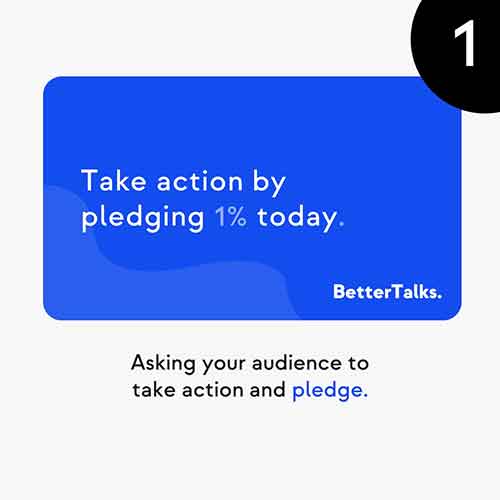
Here were asking the audience to take action by using the wording “take action” in our copy. This call to action is a pledge to donate. A clear message like this can be helpful for charities and non-profits looking to raise funding for their campaign or cause.
2. Encourage your audience to take a specific action, e.g. joining your cause or community
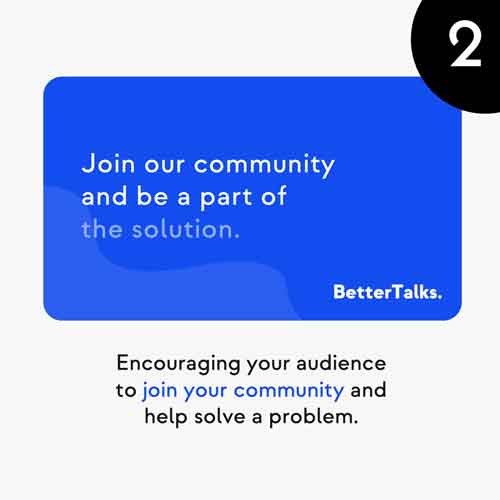
Here was are asking the audience to join our community and help solve a problem by becoming part of the solution. It’s a simple call to action. You can pass the touch to your audience and ask them to take the next lead.
3. Highlight the critical points for your audience to remember.
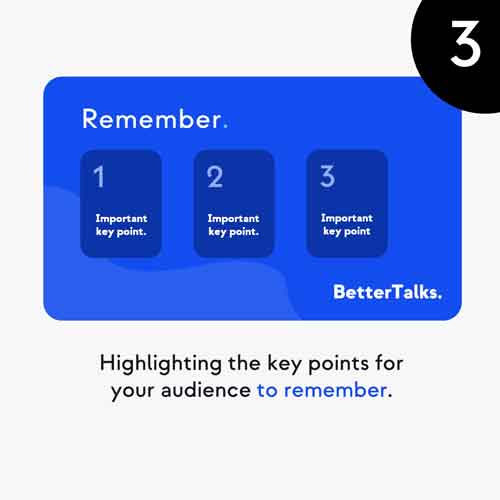
Rember, to summarise your presentation into no more than three key points. This is important because the human brain struggles to remember more than three pieces of information simultaneously. We call this the “Rule of Three”.
4. If you are trying to get more leads or sales end with a call to action to book a demo or schedule a call.
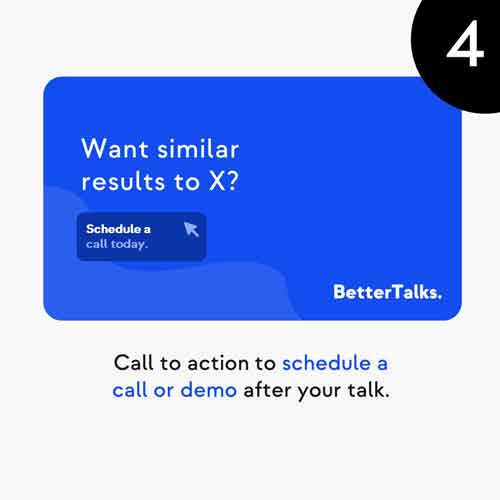
Can you inspire your audience to sign up for a demo or trial of your product? Structure your talk to lead your prospect through a journey of the results you generate for other clients. At the end of your deck, finish with a specific call to action, such as “Want similar results to X?”
Make sure you design a button, or graphic your prospect can click on when you send them the PDF version of the slides.
5. Challenge your audience to think differently or take action, e.g. what impact could they make?
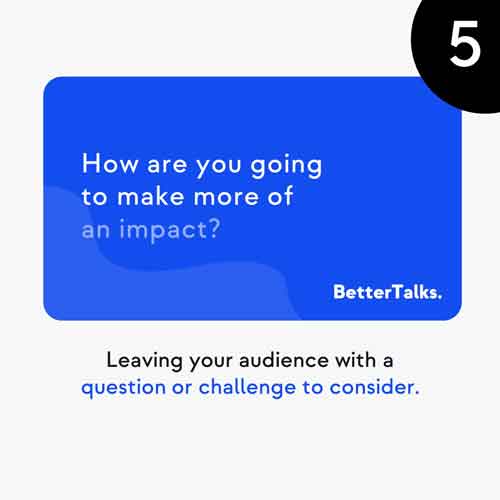
6. Give your audience actions to help share your message.
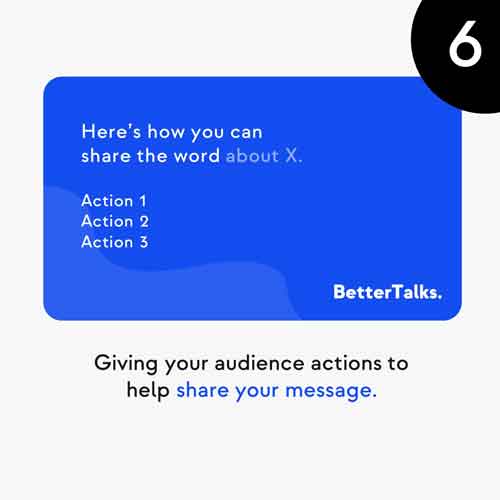
7. Promote your upcoming events or workshops
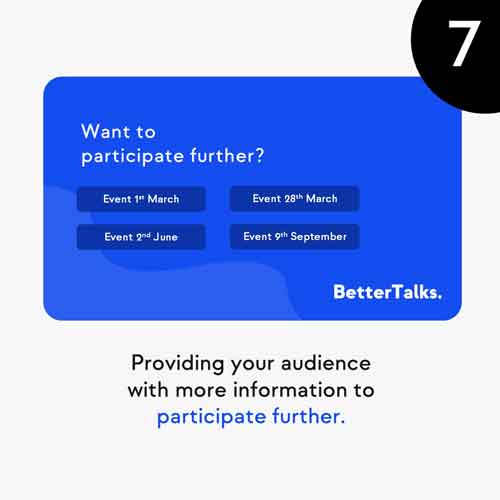
8. Asking your audience to become a volunteer.
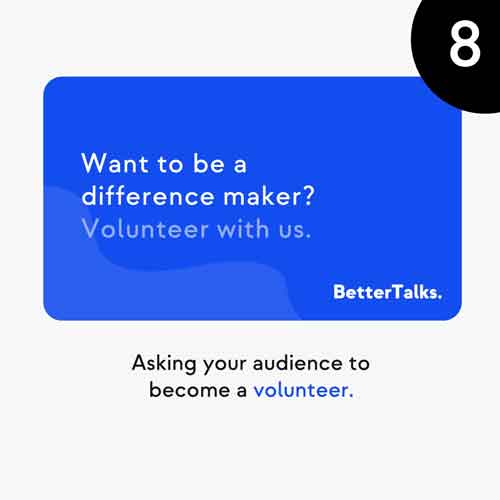
9. Direct your audience to learn more about your website.
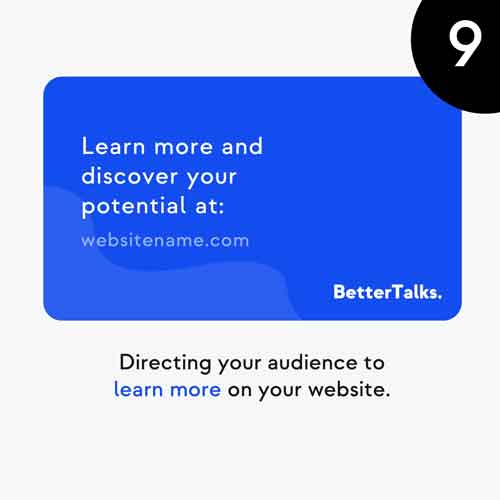
10. If you are a book author, encourage your audience to engage with your book.
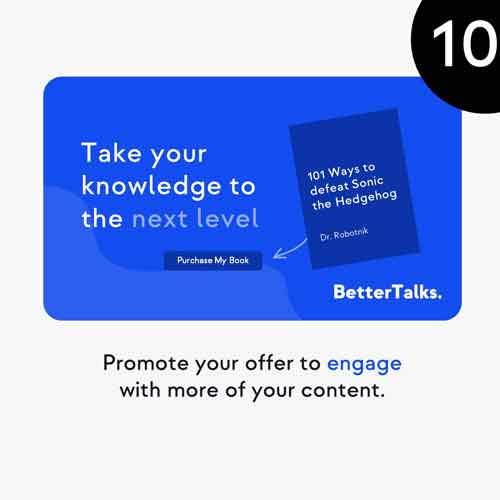
6 Questions to Generate an Ending for Your Presentation
You’ve told an engaging story, but why end your presentation without leaving your audience a clear message or call to action?
Here are six great questions you can ask yourself to generate an ending for your presentation or keynote talk.
- What impression would you want to leave your audience with?
- What is the big idea you want to leave them with?
- What action should they take next?
- What key point should you remember 72 hours after your presentation?
- What do you want them to feel?
- What is the key takeaway for them to understand?
What to Say After Ending a Presentation?
When you get to the end of a book, you don’t see the author say, “thank you for reading my last chapter.” Of course, there is no harm in thanking the audience after your presentation ends, but don’t make that the last words you speak.
Think of the ending of the presentation as the final chapter of an epic novel. It’s your chance to leave a lasting impression on the audience. Close with an impactful ending and leave them feeling empowered, invigorated and engaged.
- Leave a lasting impression.
- Think of it as the last chapter of a book.
- Conclude with a thought or question.
- Leave the audience with a specific action or next step.
How to End a Presentation with Style?
There are many great ways you can end your presentation with style. Are you ready to drop the mic?
Ensure your closing slide is punchy, has a clear headline, or uses a thought-provoking image.
You want to capture the audience’s attention before closing the presentation. Make sure the fonts you choose and are clear and easy to read. And What are the Best Colours for Your PowerPoint presentation? Use them wisely.
Do you need to consider adding a link? If you add links to your social media accounts, use icons and buttons to make them easy to see. Add a link to each button or icon. By doing this, if you send the PDF slides to people, they can follow the links to your various accounts.
What Should you Remember?
💡 If you take one thing away from this post, it’s to lose the traditional ending slides. Let’s move on from the “Thank you for your attention.” or “Any questions.” slides.
These don’t help you or the audience. Respect them and think about what they should do next. You may be interested to learn 3 Tactics to Free Your Presentation Style to help you connect to your audience.
Create stunning presentations with our templates, toolkits and guides.
Illiya Vjestica
Share this post:, related posts.
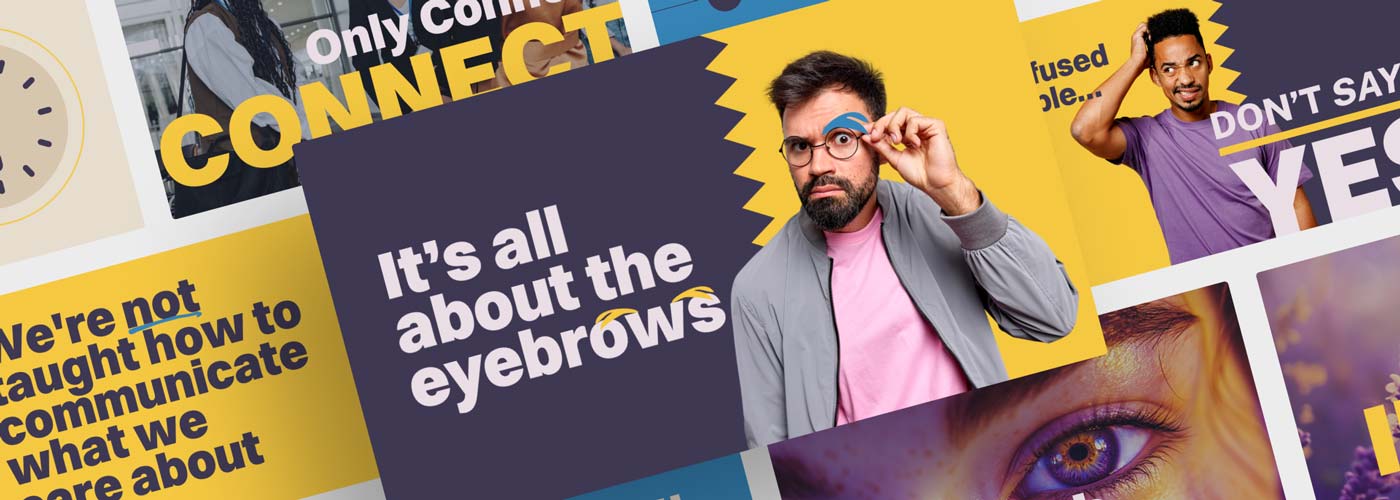
Make Your Slides Intriguing Like Author Sam Horn
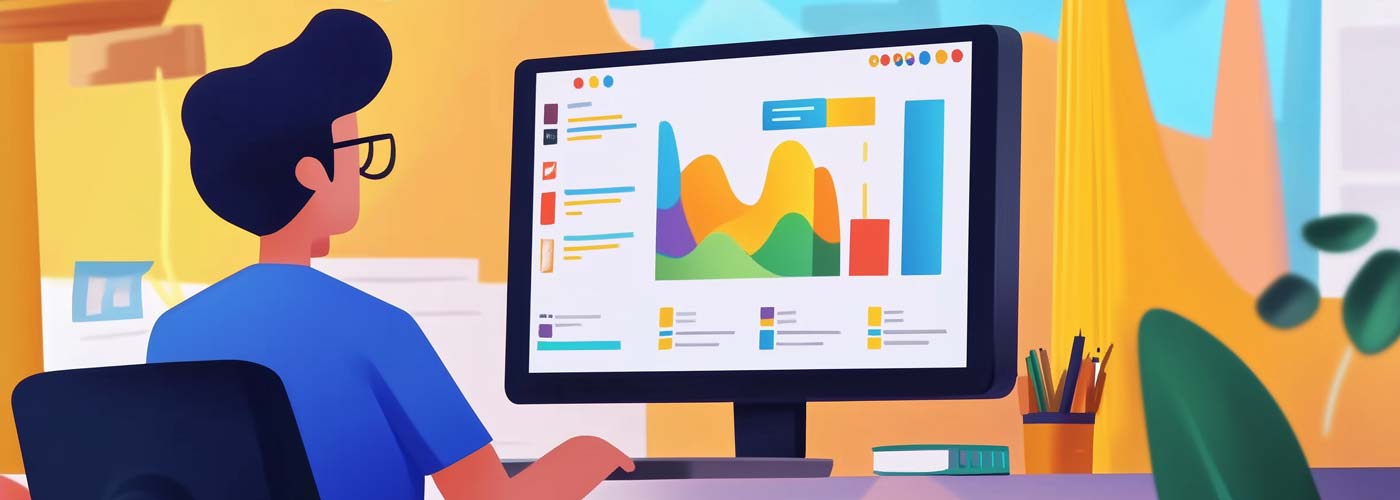

7 Surprising Benefits of Using Google Slides
Leave a comment cancel reply.
Your email address will not be published. Required fields are marked *
We use cookies to enhance your experience. By continuing to visit this site, you agree to our use of cookies
- Collections
Strategy / Business Plan
- The End Powerpoint Template
The End PowerPoint Presentation Template and Google Slides

Multi-Color PowerPoint Template To End Your Presentation
About the template:, features of this template:.
- 100 % customizable slides and easy to download.
- Slides available in different nodes & colors.
- The slide contained 16:9 and 4:3 format.
- Easy to change the slide colors quickly.
- Well-crafted template with instant download facility.
- Perfect slide to end your presentation.
- Warmest Thanks
- Business Thanks
- Business Thank You
- Google Slides

296+ Templates

1105+ Templates

Team / Teamwork
369+ Templates

6705+ Templates

55+ Templates

492+ Templates

413+ Templates

72+ Templates

686+ Templates

13+ Templates
You May Also Like These PowerPoint Templates

Concluding a PowerPoint Slide: Tips for a Strong Finish
Wrapping up a PowerPoint presentation can feel like a daunting task, but it’s crucial for leaving your audience with a lasting impression. Let’s dive into how to effectively conclude a PowerPoint slide. The key is to summarize your main points, reiterate your message, and end with a call to action or a thought-provoking question. Remember, the goal is to make your conclusion memorable, concise, and impactful.
Step by Step Tutorial: Concluding a PowerPoint Slide
Before we jump into the steps, it’s important to understand that concluding a PowerPoint slide effectively will help reinforce your message and encourage your audience to take action or further engage with your content. Let’s get started.
Step 1: Summarize the Main Points
Begin your conclusion by briefly summarizing the main points of your presentation.
After discussing several aspects of your topic, it’s easy for the audience to get overwhelmed with information. By summarizing, you’re reminding them of the core points and ensuring they leave with a clear understanding of your presentation.
Step 2: Reiterate Your Message
In your conclusion, make sure to reiterate the central message or thesis of your presentation.
This is your last chance to emphasize the importance of your topic. Whether you’re trying to persuade, inform, or inspire, driving your message home one last time can make all the difference in how it resonates with your audience.
Step 3: End with a Call to Action or Question
Finish your PowerPoint slide by encouraging your audience to take action or ponder a thought-provoking question related to your topic.
This step is crucial for engagement. A call to action might prompt your audience to try a new product, implement a strategy, or join a cause. A thought-provoking question, on the other hand, can linger in their minds, keeping them connected to your presentation long after it’s over.
After completing these steps, your audience should feel informed, motivated, and ready to respond to your presentation’s content. Whether they’re discussing it among themselves, reaching out for more information, or taking immediate action, a well-concluded slide sets the stage for ongoing engagement.
Tips for Concluding a PowerPoint Slide
- Keep it short and sweet; your conclusion should be a concise wrap-up, not a second presentation.
- Use clear and strong language to leave a definitive final impression.
- Avoid introducing new information in your conclusion; stick to what you’ve already covered.
- Practice your closing remarks to ensure a smooth and confident delivery.
- Consider using a visually striking image or quote on your final slide for added impact.
Frequently Asked Questions
What if i have a lot of information to summarize.
Focus on the key takeaways that you want your audience to remember. It’s better to be clear and concise rather than overwhelm your audience with too much information at the end.
Can I use a quote to conclude my PowerPoint slide?
Absolutely! A relevant and powerful quote can be an effective way to underscore your message and leave a lasting impression on your audience.
Should I take questions after my conclusion?
Taking questions after your conclusion can be a great way to engage with your audience further, but make sure your conclusion stands strong on its own first.
How long should my conclusion be?
Your conclusion should be brief, ideally no more than a minute or two. The goal is to succinctly wrap things up and reinforce your main points.
Is a call to action always necessary?
While a call to action is not always necessary, it can be a powerful way to encourage your audience to engage with your content beyond the presentation.
- Summarize the main points.
- Reiterate your message.
- End with a call to action or question.
Concluding a PowerPoint slide isn’t just about ending a presentation; it’s about leaving your audience with something to remember. It’s your final chance to drive home your message, emphasize the importance of your topic, and inspire action or further conversation. Whether you’re in a classroom, a boardroom, or a virtual meeting, the way you wrap up your slides can make a world of difference. So, take a deep breath, review your key points, and deliver that closing with confidence. Remember, a strong conclusion can turn a good presentation into a great one. Keep practicing, keep refining, and keep engaging your audience until the very last slide.

Matt Jacobs has been working as an IT consultant for small businesses since receiving his Master’s degree in 2003. While he still does some consulting work, his primary focus now is on creating technology support content for SupportYourTech.com.
His work can be found on many websites and focuses on topics such as Microsoft Office, Apple devices, Android devices, Photoshop, and more.
Share this:
- Click to share on Twitter (Opens in new window)
- Click to share on Facebook (Opens in new window)
Related Posts
- How to Rotate a Powerpoint Slide Presentation
- How to Delete a Slide in Powerpoint 2010: Step-by-Step Guide
- How to End Powerpoint on Last Slide in Powerpoint 2010: A Step-by-Step Guide
- How to Download a Google Slides Presentation as a Powerpoint File
- How to Hide a Slide in Powerpoint 2010: A Step-by-Step Guide
- How to Add Bullet Points in Google Slides: A Step-by-Step Guide
- How to Put Embedded Youtube Video in Powerpoint 2010: A Step-by-Step Guide
- Can You Save a Powerpoint as a Video in Powerpoint 2013? Find Out Here!
- How to Add a New Slide in Google Slides: A Step-by-Step Guide
- How to Change Slide Size in Powerpoint 2016
- How to Embed a YouTube Video in Powerpoint 2013: A Step-by-Step Guide
- How to Remove Slide Numbers in Powerpoint 2019: Easy Steps
- How to Make a Powerpoint Slide Vertical in Powerpoint 2013: A Step-by-Step Guide
- How to Save Powerpoint as PDF with Notes: A Step-by-Step Guide
- Troubleshooting Powerpoint Designer Not Working on Windows 11: Fixes and Tips
- Keeping Track of Word Counts in PowerPoint: Tips and Tricks
- Determining the Size of a PowerPoint Slide in Pixels: A Guide
- How to Delete a Slide in Powerpoint: 2024 Guide for Easy Removal
- How to Exit Slide Master View in Powerpoint 2010: A Step-by-Step Guide
- How to Add Page Numbers in Powerpoint 2010: A Step-by-Step Guide
Get Our Free Newsletter
How-to guides and tech deals
You may opt out at any time. Read our Privacy Policy
10 Tips On How To End A Presentation [Examples + Templates]
Everyone agrees that the beginning of a presentation is crucial as it catches your audience’s attention and keeps them engaged, but what about the ending? The end of a presentation is as important as the start, which leaves a strong impression! A strong conclusion can transform a good presentation into a memorable one, but how do you end a presentation? That is exactly what this blog is going to help you with. In this blog, you will learn tips on how to end a presentation, a few common mistakes to avoid, and a lot more! So, what is the wait? Let’s dive in!
Why Is It Important To Have A Conclusion Slide In Your Presentation?
A conclusion is where, as a presenter, you have the opportunity to hammer the nail on its head and leave a memorable impression. But that is not all a conclusion should do; according to Business Communication: Process and Product should achieve three goals:
1. Summarize the main points of the slideshow. 2. Leaves the audience with a key takeaway. 3. Includes a statement that allows you to leave or pass on the mic.
A good conclusion is like the perfect punchline to a good joke; hence, you need to create a solid conclusion that drives your message home and everyone remembers it.
10 Tips On How To Conclude A Presentation
Now, let’s get onto the part that you have been waiting for! It’s time to discover the various tips on how to wrap up a presentation; these tips will not only help you craft a strong conclusion but also will help you learn various methods of delivering your conclusion!
1. Summarize key points
You have company if you struggle to remember what to say at the end of a presentation. Most people do not realize that an overall content summary is often the most fundamental part of an ending. One of the best ways to end a presentation is by summarizing 3-4 major points from your slideshow. This allows you to ensure that everyone present remembers these few points and their context and walks out with the message.
2. End on a Strong Note
While a summary ensures that your audience knows the key highlights of your presentation, it is equally important that your presentation stays memorable. An essential point on how to end and conclude your presentation is by giving it the conclusion it deserves. As the introduction mentions, an audience will often try to remember information by attempting to recall the beginning or end, so try to make the end memorable and even more important in the context of your entire presentation.
Example: If you started with a personal anecdote, revisit it and show how your presentation has provided the solution or insight.
3. Add a Call To Action

A CTA gives the audience something to do after the presentation. This could be as simple as visiting a social media page, signing up on a website, contacting the presenter for anything related to the presentation, or following up on a future presentation or event. This makes the audience an active part of your presentation rather than passive listeners and makes them feel included and involved, where they are participants rather than mere spectators.
4. Ask questions that make your audience think
Ask a rhetorical, thought-provoking question for which your audience must think back to your presentation for answers. Another way of doing this is by presenting your question at the beginning of the presentation and circling back to it by introducing the audience with enough information to answer it after the ending slide of the presentation. This allows you to make your presentation more interactive and helps you retain your audience’s attention.
5. Have brief answers ready
When you think of how to close a presentation, being ready with brief answers to questions that you might ask is the best way! Sometimes, less is more when facing a question at the end of your presentation. This means that you try to keep your answers as short and crisp as possible, as it shows how well-versed you are with the information and to keep your audience’s interest piqued. Practice on questions you have thought about to give you someplace to start and think about how the audience will receive the answers to prepare accordingly.
6. End with a quote

Another great way on how to end a PowerPoint presentation is by using quotes. When talking about quotes, we don’t mean the typical, overused “words of wisdom” you see in every presentation. To go out on a strong note, quote someone relatable or relevant to the context of your presentation; keep the quote as relatable as possible. Don’t go out of your way to find overly philosophical sayings that go over your audience’s head; instead, find something that gives your presentation a conclusion that speaks for itself.
7. Tell a story
One of the best ways to end a presentation is to take the audience on a narrative journey and bring it full circle to relate it to something you said in the beginning. This could be as easy as answering a question you laid out at the beginning of a simple quote that relates to the situation after the end of the presentation. This makes it seem like you have rehearsed and planned a complete conclusive presentation, which helps your reputation as a presenter.
8. Use strong visuals
We are all familiar with the phrase “a picture is worth a thousand words,” which means that an image can strike a chord with the audience in a way that words simply cannot. Use vibrant colors and themes, maintain an aesthetic, and include background images and other elements to improve the quality of your presentations and make them more memorable with your audience. They are more likely to remember and recall a visual presentation rather than a boring, text-heavy presentation slide, making it a great method when you think about how to conclude a presentation.
9. Ask for feedback
One of the best ways to conclude a presentation is by asking for feedback from your audience right after thanking them. So, how can you ask them for feedback? It is pretty simple; all you have to do is ask everyone to share their thoughts about the presentation through a series of Q&A sessions, or you can approach people individually after the presentation. When you conclude a presentation by asking for feedback, it shows that you truly value their time and input as well, and it even helps you grow!
10. Use a conclusion slide
The last tip on how to end a presentation has to be to use a conclusion slide. Many people use a thank you slide, but those slides hardly help close a slideshow. You can end a presentation by saying ‘Thank You,’ but it won’t have the same effect as having a conclusion that summarizes everything. A good conclusion helps you deliver the message you have been conveying throughout the presentation.
Common Mistakes To Avoid When Ending A Presentation
Now that you know how to conclude a PowerPoint presentation, you should also be aware of a few mistakes you can make when creating a conclusion for your presentations.
1. Being overly lengthy
It is best if you keep it brief as a presenter. The last thing an audience wants to hear in a conclusion is a detailed overview of what they just went over. Limit yourself to just the key takeaways rather than a story similar to what has already been presented to ensure an audience listens to you rather than tuning themselves out.
2. Not having a precise meaning
Ending a presentation can quickly become very awkward if you have not prepared how to close a presentation as it transitions into an abrupt silence or unplanned conversation. Be sure to include a definite ending to your presentation so that there is no confusion between you and the audience, letting them know you have concluded your presentation.
3. Not thanking your audience and team

One of the last things you do as a presenter is thank all parties involved for all their contributions. This begins with thanking team members – those who compiled the slideshow, those who went through the efforts to find the relevant data and information, and those who are direct team members. This is an easy and efficient way to acknowledge those who have been involved with a project and give them the credit that they deserve for the work that they have put in.
Finally, thank the audience for their time, patience, efforts, and respect to ensure they feel seen and understood at the end of the presentation. This is an etiquette for appreciating them and their participation. To add to your visuals, add a Thank You slide after your conclusion that encompasses your brand identity. Interestingly, you can combine it with the Contact Us page to make it more streamlined and include all vital information in a single slide.
How To End A Presentation Slides And Examples
If you are curious about what a good conclusion slide looks like, you can take a look at a few of SlideUpLift’s conclusion PowerPoint templates . These templates work as an inspiration and can be used directly in your presentation as well, as they are 100% customizable, allowing you to make the template into your slide.

Now that you know how to end a presentation like a pro, it is time for you to start creating slideshows that have conclusions that achieve all three goals a conclusion should. While knowing how to end a presentation, it is also great to learn how to create a title slide that will captivate your audience. So, get out there and create stunning presentations that portray everything you want!
How do you end a presentation?
To begin wrapping up your presentation, start by providing a summary of the presentation and key points, and follow that up with one of the CTA, Quotes, or Questions. Anticipate what the audience may ask, and provide contact details that will let the audience reach out to you. Finally, thank the audience and your team for all their efforts and time.
Should I end a presentation with a joke?
Ending a presentation with a joke is a very situational instance where you can afford to make a joke casually and informally with your peers. However, jokes may backfire with executives and team leaders in a more formal setting.
How can I make my presentation conclusion more memorable?
Using a quote or statistic, you can make your presentation conclusion more memorable. You can also tell a relatable story or anecdote while asking a thought-provoking question. Additionally, add visual elements to incorporate the message you are sending.
What do you say at the end of a presentation?
A few common phrases that you can say at the end of a presentation include:
- Thank you for your time.
- I appreciate the opportunity to speak with you today.
- I’ll now answer any questions you have.
Table Of Content
Related presentations.

Thank You Slide Templates

End Slide Templates

Conclusion Slide Templates
Related posts from the same category.

22 Jul, 2024 | SlideUpLift
17 Tips On How To Write A Professional PowerPoint Presentation [+Templates]
Presentations are a fantastic tool for communicating vital information. Even though people think it's simple to put all your content together and make a presentation, arranging and preparing the template

31 Jul, 2024 | SlideUpLift
How To Introduce Yourself Professionally [Examples + Templates]
Are you tired of the same old, boring self-introductions? It's time to step into the spotlight and make a memorable entrance. Whether you're facing a panel of interviewers or a

10 Best Financial Presentation Examples For PowerPoint
Presenting large data in a concise format in a presentation is just as important as it affects the efficiency of your business decision-making process. To make your work easy, we

10 Dec, 2024 | SlideUpLift
Top 10 Hacks On How To Make PowerPoint Presentation Attractive
Per experts, the audience gets hooked and pays more attention to the visual content of your PowerPoint slides than drab-looking, text-heavy content. This article answers the well to know question

4 Oct, 2023 | SlideUpLift
The Best And Worst PowerPoint Presentation Examples
Engaging presentations are the lifeblood of effective communication in today's information-driven world. Whether you're in a boardroom pitching a new idea, standing in front of a classroom of curious learners,

23 Aug, 2024 | SlideUpLift
The Best PowerPoint Presentation Examples To Get Inspired By!
Engaging presentations are the secret sauce of effective communication. They bring life to your ideas and transform information into inspiration. They are the heartbeat of any memorable message, connecting with

22 Aug, 2024 | SlideUpLift
Best Professional Presentation Examples To Inspire You [+ Premium Templates]
It’s crucial for professionals to deliver outstanding and engaging presentations that convey essential information to their teams and stakeholders. Most professional PowerPoint themes are the backbone of corporate presentations and

27 Sep, 2023 | SlideUpLift
10 Bad PowerPoint Slides Examples to Avoid
A presentation serves two purposes: 1) it teaches your audience something new and 2) motivates them to take action. However, achieving these goals is only possible if your audience is

6 Jan, 2021 | SlideUpLift
How To Start a Presentation : Make A Strong First Impression
Presenting well requires preparation, and the first step is mastering the art of the opening statement. You may pique your audience's curiosity by crafting a captivating introduction to your presentation.

10 Nov, 2021 | SlideUpLift
PowerPoint Presentation Tips: How to Make a Good PowerPoint Presentation
A well-crafted PowerPoint presentation can have a lasting impact on your audience. However, creating an effective presentation can be daunting, especially if you are unsure how to make it engaging
Related Tags And Categories
Forgot Password?
Privacy Overview
Necessary cookies are absolutely essential for the website to function properly. This category only includes cookies that ensures basic functionalities and security features of the website. These cookies do not store any personal information
Any cookies that may not be particularly necessary for the website to function and is used specifically to collect user personal data via ads, other embedded contents are termed as non-necessary cookies. It is mandatory to procure user consent prior to running these cookies on your website.

IMAGES
VIDEO
COMMENTS
PowerPoint layout templates for surprisingly good intro and finish slides for your presentations.
When you reach the end of your presentation, summarizing the main points helps your audience retain the important information you've shared. Crafting a memorable summary enables your listeners to walk away with a clear understanding of your message.
That's why we created this article to teach you how to end a presentation. In this article, we're going to explore six awesome ways to close your presentation with style. These techniques will help you leave a lasting impact and make your audience go "Wow!"
Here are 10 powerful examples of how to end a presentation that does not end with a thank you slide. How many presentations have you seen that end with "Thank you for listening" or "Any questions?" I bet it's a lot… "Thank you for listening." is the most common example.
This tutorial will help you nail the finish of your presentation and leave your audience with a lasting impression. I'll also show you do's and don'ts for finishing your presentation with attractive final concluding slides. Let's dive in.
Slides available in different nodes & colors. The slide contained 16:9 and 4:3 format. Easy to change the slide colors quickly. Well-crafted template with instant download facility. Perfect slide to end your presentation.
3 Alternatives to Thank You Slides for PPT. Presenters have plenty of choices when concluding a presentation. If you're feeling like the traditional "thank you slide" for PPT doesn't fit the content, here are some other options.The end slide can inspire your audience or action or create a dialogue with the right design.
Let's dive into how to effectively conclude a PowerPoint slide. The key is to summarize your main points, reiterate your message, and end with a call to action or a thought-provoking question. Remember, the goal is to make your conclusion memorable, concise, and impactful.
The end of a presentation is as important as the start, which leaves a strong impression! A strong conclusion can transform a good presentation into a memorable one, but how do you end a presentation? That is exactly what this blog is going to help you with.
There are types of endings and tips for giving your presentation. You can also cite our examples in your slides. You can also generate well-crafted presentations with our online AI presentation maker. Effortlessly, you can receive professional and well-designed slides in just one click.